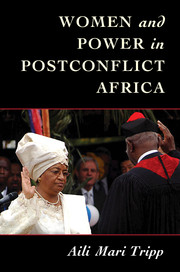Book contents
- Frontmatter
- Epigraph
- Dedication
- Contents
- List of Tables
- List of Figures
- Map of Africa
- List of Acronyms
- Acknowledgments
- Preface
- Part I Setting the Stage
- 1 Introduction
- 2 Pathways to Change in Women's Rights
- Part II Case Studies
- Part III New Openings for Women's Rights
- Part IV Gendered Outcomes
- Part V Future Research
- References
- Index
2 - Pathways to Change in Women's Rights
from Part I - Setting the Stage
Published online by Cambridge University Press: 05 November 2015
- Frontmatter
- Epigraph
- Dedication
- Contents
- List of Tables
- List of Figures
- Map of Africa
- List of Acronyms
- Acknowledgments
- Preface
- Part I Setting the Stage
- 1 Introduction
- 2 Pathways to Change in Women's Rights
- Part II Case Studies
- Part III New Openings for Women's Rights
- Part IV Gendered Outcomes
- Part V Future Research
- References
- Index
Summary
In moments of crisis, the wise build bridges and foolish build dams.
– Nigerian proverbFor women's rights activists, there may have been a silver lining to the relentlessly long and brutal conflicts that so many African countries experienced. Postconflict countries in Africa adopted distinct and more rapid trajectories of change in gender regimes after 1990 and especially after 2000. Gender regimes refer to gender-based systems of hierarchy and power within social systems or institutions. This chapter elaborates the causal mechanisms that explain the postconflict trajectories and processes of change, and the case studies in subsequent chapters go further in depth to trace the processes of change. I isolate the causal mechanisms by comparing the differences between the more successful outcomes in Uganda and Liberia with the less successful case of Angola in Chapters 3, 4, and 5, and they are considered against the broader backdrop of postconflict and nonconflict countries.
This chapter shows in broad strokes how the decline in conflict is linked to the emergence of a new gender regime (including positive women's rights and leadership changes) primarily through the following causal mechanisms: (1) gender disruptions, (2) women's movements, and (3) the spread of new international gender norms, resulting in interventions by international actors like the United Nations (UN) and foreign donors (see Figure 2.1). The conjuncture of these three conditions was necessary to explain the changes in Africa starting in the 1990s with respect to women's rights reform. If any of these factors was missing, considerably less change occurred. In Chapter 1 this was referred to as the hoop test, which identifies conditions that are necessary for a hypothesis to be true.
The precipitous decline in conflict in Africa was accompanied by political liberalization, which allowed women's movements and donors to press for the increased adoption of women's rights in peace agreements, constitutions, and other changing opportunity structures (see Figure 2.1). The changes we have seen in postconflict African countries (and beyond) can be explained by a convergence of a series of developments that are global, but have a particular African dimension to them because so many countries in Africa had experienced conflict.
- Type
- Chapter
- Information
- Women and Power in Postconflict Africa , pp. 33 - 46Publisher: Cambridge University PressPrint publication year: 2015

